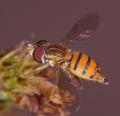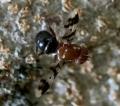Diptera.info :: Identification queries :: Diptera (adults)
Who is here? 1 guest(s)
|
Question: Quaedfly
|
|
| mayallbehappy |
Posted on 01-10-2006 18:55
|
|
Member Location: Posts: 6 Joined: 01.10.06 |
Hi, I know of a dutch family named Quaedfly. And I was wondering is it a real fly? And were flies common knowledge in the time of Napoleon when people chose their familynames?
Edited by mayallbehappy on 01-10-2006 19:01 |
|
|
|
| Kahis |
Posted on 01-10-2006 19:03
|
|
Member Location: Helsinki, Finland Posts: 1999 Joined: 02.09.04 |
Nothing shows up on google. I guess the knowledge of 'the common man' was better then that it is now. Which is not saying much. Who would not know about the existence of flies? But that's about as far as it gets today. Kahis |
| Tony Irwin |
Posted on 01-10-2006 19:11
|
|
Member Location: Norwich, England Posts: 7280 Joined: 19.11.04 |
I wonder if this is the same as Gadfly? This name is used for horseflies (Tabanidae) and horse botflies (Gasterophilidae), as well as any irritating person! 
Tony ---------- Tony Irwin |
|
|
|
| Paul Beuk |
Posted on 02-10-2006 07:55
|
|
Super Administrator Location: Netherlands Posts: 19403 Joined: 11.05.04 |
The family name is (in different spellings) 'quaedvlieg' or 'quaedflieg' (also with variation in the use of ae, aa and a). I have not with certainty been able to establish the etymology. According to a Dutch insitute for social studies it has been proposed to be related to 'bad flies' as in flies that transmit desease to cattle, in particular mastitis, which is transmitted by Hydrotaea irritans. It beats me why anyone should want that as a family name...
Edited by Paul Beuk on 02-10-2006 08:06 Paul - - - - Paul Beuk on https://diptera.info |
| Louis Boumans |
Posted on 02-10-2006 16:18
|
|
Member Location: NO Oslo Posts: 262 Joined: 09.06.04 |
Check http://www.meertens.knaw.nl/ for Dutch family names. There it says it is derived from a toponym, i.e. a place name that occurs twice in southern Limburg. Also most people with this name are still found in Limburg. |
|
|
|
| mayallbehappy |
Posted on 01-11-2006 14:32
|
|
Member Location: Posts: 6 Joined: 01.10.06 |
Well thanks everyone for all your helps and comments. Its true, I made the name quaedvlieg english because of the english site. I looked it up at the dutch institute for social studies. I encountered the name with a judge, in 's Hertogenbosch if I am not mistaken. What supprised me was the apparent knowledge of a diversity in flies at that time. At first I became a disbeliever because of my underestimation of the skills and knowledge of some people in that time. But the explanation that is was related to a village makes it more trustworthy. Strange that people call their village after a fly; Hydrotaea irritans. So thanks again and buzz ... on with your lives. |
|
|
|
| mayallbehappy |
Posted on 01-11-2006 14:33
|
|
Member Location: Posts: 6 Joined: 01.10.06 |
does any one have a picture of the hydrotaea irritans? |
|
|
|
| mayallbehappy |
Posted on 01-11-2006 14:42
|
|
Member Location: Posts: 6 Joined: 01.10.06 |
Well I encountered more. I also encountered the names toponiem Quaadvlieg te Valkenburg-Houthem, Koevliegenstraat or Koeivliegenstraat (< Kwade Vliegenstraat) in Maastricht. Reverring to the interpretation of a cowfly or an angry flies. So I was wondering, is the hydrotaea irritans a cowfly? Or known for his anger? I have heard of killer bees, but angy flies? Does anyone know of any interesting stories related to that subject? |
|
|
|
| mayallbehappy |
Posted on 01-11-2006 15:25
|
|
Member Location: Posts: 6 Joined: 01.10.06 |
From looking things up, I encountered some photo which was taken in such a way that the sixth leg almost like like a stinger thing at the end of the body, making it look like a muskito. Another thing I encountered and which I think you may all find very interesting is a paper titled Morphology and number of sensilla on the antennae and maxillary palps of different sized houseflies, and here is the link of the pdf file; dissertations.ub.rug.nl/FILES/faculties/science/2001/f.j.kelling/c2.pdf I am sure you love it, it has some interesting closeup pictures in it. Strangely enough, the hydrotaea irritans is mentioned in it as well, while the hydrotaea irritans doesn't appear to me as a housefly. I still haven't figured out for sure if it is the same as the quaedflieg, but it seems likely, for cattle has earprotection against them. Somehow the quaedflieg likes milkremains on the udders and thus transmits deceases. By the usage of earplugs of the cow the udders remain sterile(some sort of walkman but then for cows and not for music but for keeping the udders clean). Well I hoped that with this link I contributed to your happiness. thanks. |
|
|
|
| mayallbehappy |
Posted on 01-11-2006 16:01
|
|
Member Location: Posts: 6 Joined: 01.10.06 |
couldn't leave this out. the muskito fly I mentioned earlier http://piclib.nhm...earch=head and the pdf file was part of a serie about the housfly or Musca domestica L.; so here are links to the rest of the document, part 1 titled General introduction; BIOLOGY OF THE HOUSEFLY dissertations.ub....ing/c1.pdf and part 3 titled; Electrophysiological characterisation of olfactory cell types in the antennae and palps of the housefly dissertations.ub....ing/c3.pdf part 4 titled; Chapter 4 Effect of age and sex on the sensitivity of antennal and palpal olfactory cells of houseflies dissertations.ub....ing/c4.pdf part 5 titled; Chapter 5 Background odour induces slight adaptation and sensitization of olfactory receptors in the antennae of Musca domestica L. dissertations.ub....ing/c5.pdf part 6 titled ; Chapter 6 Spatial and temporal characteristics of electroantennograms in flies dissertations.ub....ing/c6.pdf part 7 titled; Chapter 7 Chemical and electrophysiological analysis of components, present in natural products that attract houseflies dissertations.ub....ing/c7.pdf part 8 titled ; Chapter 8; Summary and general discussion dissertations.ub....ing/c8.pdf Read it like if it were your last act, so that if you were to die right now, it would be with a smile on your face for knowing everything about the flies you attract and why they are so interested in you lying dead. I really hope you to be very happy with this. Edited by mayallbehappy on 01-11-2006 16:04 |
|
|
|
| Paul Beuk |
Posted on 01-11-2006 16:37
|
|
Super Administrator Location: Netherlands Posts: 19403 Joined: 11.05.04 |
mayallbehappy wrote: Well I encountered more. I also encountered the names toponiem Quaadvlieg te Valkenburg-Houthem, Koevliegenstraat or Koeivliegenstraat (< Kwade Vliegenstraat) in Maastricht. Reverring to the interpretation of a cowfly or an angry flies. So I was wondering, is the hydrotaea irritans a cowfly? Or known for his anger? I have heard of killer bees, but angy flies? Does anyone know of any interesting stories related to that subject? The translation of 'kwaad' in the present meaning would be 'angry', but in the older days it would also be 'bad', 'evil', in this case probably meaning that the flies were bad for the cows, i.e., transmitting desease. Paul - - - - Paul Beuk on https://diptera.info |
| Kahis |
Posted on 01-11-2006 17:49
|
|
Member Location: Helsinki, Finland Posts: 1999 Joined: 02.09.04 |
Hydrotaea irritans is indeed irritating. The flies love to suck moisture and nutrients from exposed skin onf mammals. It is a major component of the cloud of flies which surrounds you if you are sweating outdoors in the countryside in late summer. Having fought with literally thousands of these a few times I don't hesitate to name them EVIL! 
Kahis |
| Jump to Forum: |













